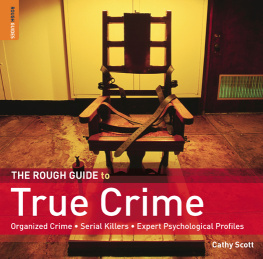Introduction
At one time, long ago, infanticide was a regularly practiced custom by earlier cultures. Infants might be disposed of due to sickness, lack of resources or other perceived weaknesses. Times though, certainly in the developed world, have changed. Our cultures idea of mothers is one of a maternal figure: Women who would walk through fire to save their children and always put their offsprings needs before their own. As we have learned, though, this doesnt always happen. Mothers who do the unimaginable and kill their children seem to make headlines every week and its a story most of us are never truly able to wrap our heads around. So whats going on and what would drive a mother to kill the one thing shes biologically meant to protect?
Maternal filicide is the technical term for the act of a mother killing her child. In some cases, the deaths are deemed to be murders, sometimes premeditated, although the charges are often reduced to manslaughter or child endangerment, depending upon the circumstances. Often, the mother is found to be mentally incompetent and unable to stand trial, or is found not guilty by reason of insanity. It is usually children under the age of eight who are killed by their mothers; those over the age of eight are more likely to be killed by their fathers, according to a 1997 study carried out by the United States Department of Justice.
So what can lead to such an atrocious act of violence? In many instances, the mother has suffered from a history of mental illness, most frequently bipolar disorder, and/or depression. However, schizophrenia, paranoid delusions, and anxiety have also been seen to historically play their part. In some cases, such as the example of Megan Huntsman, drug abuse has been blamed for the resulting acts of violence.
While mental illness is the most common defense for their actions, other motivations are often sought by the prosecution. In the case of Susan Smith, for instance, although she did suffer from a history of mental health problems, the prosecution also blamed her relationship with a man who claimed he didnt want children as one of her primary motivations for killing hers. In one of the most famous maternal filicide cases, Diane Downs was also accused of murder and attempted murder, the motivation being that her paramour (a married man) didnt want children.
A psychiatry professor at Case Western Reserve University in Cleveland, Philipp Resnick, suggests a variety of filicide types exist including: Altruistic filicide, spouse or partner revenge filicide, accidental filicide, unwanted child filicide, or that which occurs in the middle of a psychotic break. (Dumalaon, 2014) In an altruistic occurrence, the mother might kill the child because they think its in the childs best interest. Although it sounds absurd, this does happen on occasion.
For instance, in 2005 Lashaun Harris killed her children by tossing them into the San Francisco Bay. While the act was violent, her psychiatrist later revealed that Lashaun had visions of the afterlife that included, basketball courts, buses, you name it. (Gafni, 2014) As someone who was homeless at the time, and suffering from mental illness, she claimed that she thought death offered a better life for her children than the one in which they were currently living.
Although women only commit 14% of the violent crimes in the country, filicide still remains prevalent, even in our Western culture. Many people believe that, regardless of the motivations of these women, mental health issues must be at play. Its hard to imagine that a mother who killed her children couldnt possibly be mentally competent. Dr. Lanny Berman of the American Association of Suicidology in Washington D.C. claims that mothers do not kill their kids unless they are seriously disturbed. (Gafni, 2014) He also thinks that the incidents themselves are rare but that they get a lot of media attention because theyre unfathomable and sensational. (Gafni, 2014)
In the following book well look at ten of the most astounding cases involving maternal filicide in the United States, including Susan Smith, Andrea Yates, Diane Downs, and some lesser known, but equally tragic, instances of filicide. In addition to looking at the mothers histories, well also take a peek at the murders and the aftermath of their horrible, inconceivable actions.
Andrea Yates
Andrea Yates might possibly be one of the most famous murderers in the United States, at least in recent collective memory. The drowning of all five of her children, coupled with her insanity pleas, rocked the nation and its a case that still frequently comes up as a hot topic on television shows, true crime specials, and in pop culture media. Not only did her crime make headlines, but the ensuing defense of postpartum depression and psychosis helped bring awareness to these types of mental health issues that hadnt previously been seen.
Who was Andrea?
Andrea and her husband appeared to have a fairly middle class life, at least on the outside. Andrea was born into a Catholic household and brought up in a religious home. She would later tell authorities she killed her children to save them from Satan. An intelligent young woman, she graduated high school at the top of her class and later graduated from the University of Houston with a degree in nursing. She and Russell "Rusty" Yates were married on April 17, 1993. They informed friends and family that they would, "Seek to have as many babies as nature allowed."
Andrea began having symptoms of depression after the birth of their fourth son, Luke. During her murder trial, it would be speculated that her depression was exacerbated by the extremist sermons of Michael Peter Woroniecki. Her family expressed concerns at her fascination with him and his sermons.
Andreas history of mental illness is well-documented. In June 1999, Andrea attempted to commit suicide by overdosing. She was prescribed antidepressants. Sadly her condition showed signs of worsening since, not long after that, she held a knife to her throat and begged Rusty to let her die. This time she was administered an anti-psychotic drug and hospitalized; happily she seemed to get better and showed signs of improvement.
Still, by that July she would have two more hospitalizations due to her again making attempts at suicide. Her prognosis was that of postpartum psychosis, which is different from postpartum depression. Only half of the women diagnosed with postpartum depression will develop this psychosis. Andreas doctors were concerned for her wellbeing. At the trial, Dr. Eileen Starbranch, Andreas former psychiatrist, testified that she advised the couple not to have any more children, because it would "guarantee future psychotic depression." Still, the couple would go on to have one more child. Andrea later told her psychiatrist that Rusty had encouraged her to have another child by using religion and her duty to procreate as a way to cajole her.
Once again, Andrea appeared to stabilize until her father passed away on March 12, 2001. At this point she stopped feeding her infant, quit taking her medication, and mutilated herself, all the while reading the Bible at an intense pace. She was hospitalized again.



















